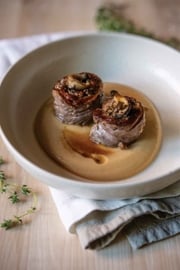Barbecued Pizza with Roasted Pepper Sauce and Spiced Chickpeas

Barbecuing pizza on a grill definitely tops baking pizza in the oven. There’s the extra crunch in the crust coupled with an added smokiness that makes it well worth the effort. We’ve topped our pizza with oven-roasted chickpeas, which can double as a snack food all by itself. Use your imagination and top your pizza with any of your favourite toppings.
Pizza
1 lb (500 g) prepared whole wheat pizza dough or Gluten-Free Pizza Dough (see recipe here)
2 cups (500 mL) baby spinach leaves, washed and spun dry
2 Tbsp (30 mL) extra-virgin olive oil, divided
Salt and freshly ground black pepper
1/2 cup (125 mL) sliced pitted black olives
1/4 cup (60 mL) crumbled vegan cheese with Italian seasonings (optional)
Spicy Roasted Chickpeas
14 oz (398 mL) can chickpeas, rinsed and drained
2 tsp (10 mL) extra-virgin olive oil
1/2 tsp (2 mL) ground cumin
1/2 tsp (2 mL) oregano
1/4 tsp (1 mL) salt
Freshly ground black pepper
Roasted Pepper Sauce
2 roasted red peppers
2 Tbsp (30 mL) extra-virgin olive oil
1/4 cup (60 mL) diced yellow onion
1 large garlic clove, finely minced
2 tsp (10 mL) fresh lemon juice
1 tsp (5 mL) smoked paprika
1/4 tsp (1 mL) salt
Divide dough into 2 equal balls. Stretch one portion at a time into a rough 12 in (30 cm) circle. Place stretched dough on parchment paper-lined baking sheet, cover, and refrigerate until ready to use. Have toppings ready before you put pizza dough on grill.
Preheat oven to 400 F (200 C). Pat chickpeas dry and place in bowl with oil and seasonings. Stir together to coat evenly and spread out on baking sheet. Bake in preheated oven for 30 minutes, stirring often. Then turn off heat and leave door ajar for chickpeas to cool.
Combine Roasted Pepper Sauce ingredients in food processor. Whirl until almost smooth but still a little chunky. Cover and set aside to allow flavours to marinate.
Stack spinach leaves one on top of the other and finely shred into strips. Place in bowl and toss with 1 Tbsp (15 mL) olive oil and a little salt and pepper to taste.
Preheat barbecue and grease grill. Brush tops of pizza dough crusts with some remaining olive oil. Place pizza dough crusts side by each on preheated grill, oiled side down and grill until golden brown on the bottom, about 3 minutes, carefully rotating for even grilling. Brush the other side of pizza dough with oil. Using spatula, carefully turn dough over. Continue to grill, carefully rotating dough until crisp and golden.
Now you can add your toppings, spreading pizzas with equal portions Roasted Pepper Sauce, shredded spinach, Spicy Roasted Chickpeas, black olives, and crumbled vegan cheese, if using. Grill for another 3 minutes, rotating pizzas frequently, checking to see that undersides are not charring. Transfer to cutting board. Cut into pieces with kitchen shears and serve.
Serves 12.
Each serving contains: 230 calories; 8 g protein; 9 g total fat (1 g sat. fat, 0 g trans fat); 30 g total carbohydrates (3 g sugars, 5 g fibre); 402 mg sodium
source: "Vegan Barbecue Feast", alive #380, June 2014





